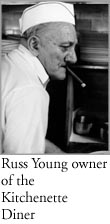 |  |  | 
 |
 |  |  |  |  |  |
 |  | 
Down Around Here is about the end of an era. Down Around Here is about change and about history.
|  |  |
 |  |  |  |  |  |
 |    |

 The Kitchenette Diner, operated by Russ Young since 1934,
was a part of David Sutherland's life growing up. The railroad car
diner was located two blocks from where his father ran a tire store. As a
kid he was drawn to the diner for its cast of characters: truckers, cops, city workers
and assorted regulars all trading stories while Russ was singing
ballads, holding mock church services and spooning out corned beef and
cabbage. In 1976, after taking over his father's tire store, David
began filming the diner after work and on weekends. He
felt the diner represented a part of Boston that was disappearing, a
glimpse of a place which remained constant, while the world changed
around it. Russ saw the filming in the same way, as a way of preserving
what he knew he was about to lose. The Kitchenette Diner, operated by Russ Young since 1934,
was a part of David Sutherland's life growing up. The railroad car
diner was located two blocks from where his father ran a tire store. As a
kid he was drawn to the diner for its cast of characters: truckers, cops, city workers
and assorted regulars all trading stories while Russ was singing
ballads, holding mock church services and spooning out corned beef and
cabbage. In 1976, after taking over his father's tire store, David
began filming the diner after work and on weekends. He
felt the diner represented a part of Boston that was disappearing, a
glimpse of a place which remained constant, while the world changed
around it. Russ saw the filming in the same way, as a way of preserving
what he knew he was about to lose.
Down Around Here is about the end of an era. As the diner's windows are boarded up and as it's being
towed away by horses, Sutherland's camera focuses in on Russ Young who
is weeping for the end of an era.
Down Around Here is about change and about history. It
is about how people react to times changing in ways they can't control by
cherishing the familiar. The railroad car diner was a link to an older
Boston, to institutions which, like the diner itself, have not always survived,
but which still embody a different kind of world than the present one. The
diner connects us to the old Boston politics of Curley and Honey Fitz, to
the Catholic church of no fish on Fridays, to the old Boston sports scene--the bygone days of Jack Sharkey and Lefty Grove. A
film about the diner became a film about the passing of that world. It's about
an institution that seemed to offer some refuge from that passing but
which ultimately couldn't hold on.

|  |